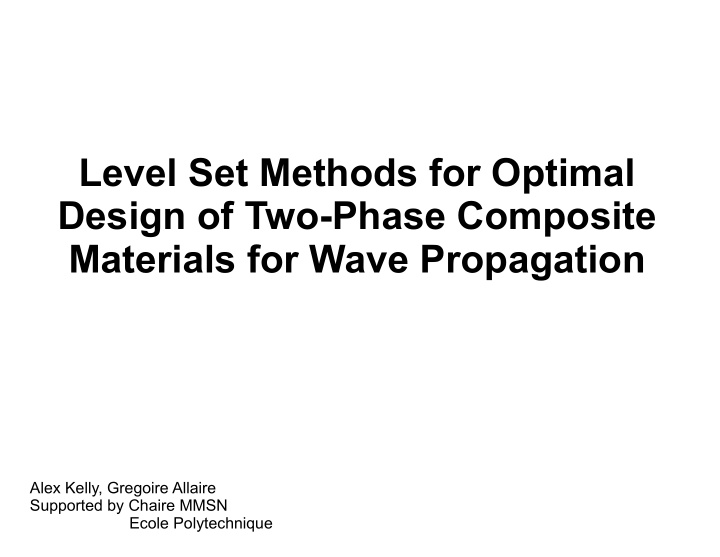



Level Set Methods for Optimal Design of Two-Phase Composite Materials for Wave Propagation Alex Kelly, Gregoire Allaire Supported by Chaire MMSN Ecole Polytechnique
Formulation of the Problem Model Problem in Conductivity Model Problem in Elasticity Find the microstructure which minimizes some objective function:
Hadamard's Method Desire determination of the Shape Derivative � Define mapping of one shape to a nearby one: Definition of directional derivative for Want to use gradient method to optimize � Exploit the form of the directional derivative: To insure we move in a descent direction select:
Shape Derivative To optimize J define the Lagrangian : Boundary Velocity-chosen to insure directional derivative of the Lagrangian < 0:
Two-Phase Complication Reformulate two separate field equations: Shape-Derivative of the associated Lagrangian: Boundary velocity determined by jump across interface : In the case of conductivity* * O. Pantz CRAS Paris (2005)
Level Set Method Phase distribution is represented by a level set function, : Zero level set represents the interface between the two phases. The evolution of the boundary is represented by the advection of the level set function: From Hamilton-Jacobi equation: Desire an application of this equation to the entire domain.
Boundary Detection Advection velocity cannot be assigned immediately to the whole field. Jump conditions can only be evaluated on the interface. Approximate sign function: “Dirac mass” on the boundary can be recovered from the sign function: Here is chosen to select the width of the boundary (usually about 5 cells to either side)
Jump Conditions � Advection Velocity Combine the actual sign function with the approximate Dirac mass to integrate the jump conditions at the interface: In practice want to smooth this away from the interface: Yields a simple variational form that can be implemented in FreeFEM++:
Implementation in FreeFEM++ Level sets tracked by characteristic Galerkin method � FreeFEM++ convect operator. convect Problems with convect operator and Finite Elements of type P2, implementation with elements of type P1 Level set function is periodically reinitialized by iteration of the scheme: To prevent formation of extraneous structures at the interface possible to penalize the total length of the interface: Which leads to new convection scheme:
A Toy Example n=5 n=25 n=45
Conclusions The evolution of the geometry in the two-phase problem is governed by jumps in the driving force at interfaces between the phases. This complication is addressed by the using information contained in the level set function to approximate the jumps at each interface. This is used as a source term in a variational form for a velocity equation easily implemented in FreeFEM++. Evolution of the level set function is accomplished by the characteristic Galerkin method that is the standard convect operator. Level set method's relative robustness with regards to 2D � 3D should make 3D implementation in FreeFEM++ relatively straightforward.
Recommend
More recommend